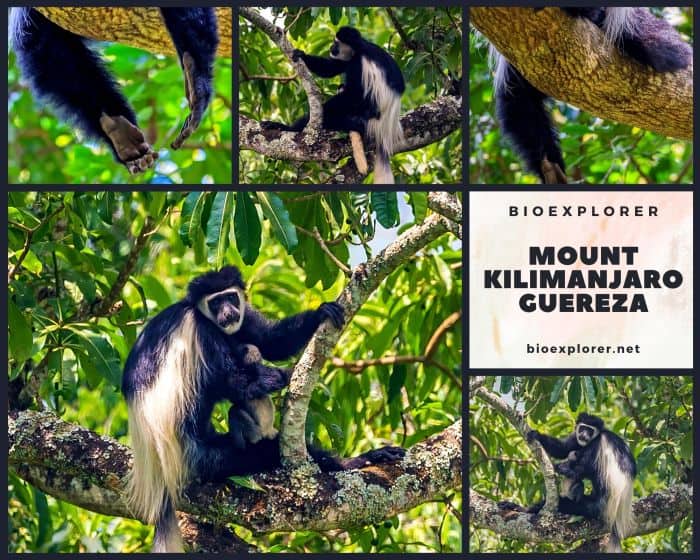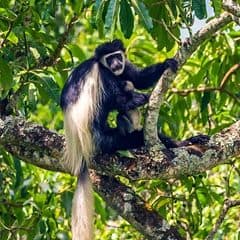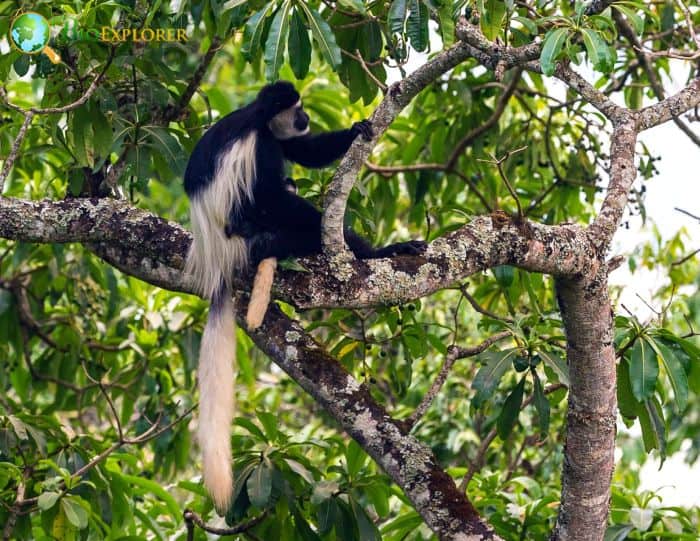


- Common Name: Mount Kilimanjaro Guereza
- Taxonomy Classification Year: 1885
- Monkey Size: 45 to 72 cm (17.72 to 28.35 in)
- Skin Color(s): Black and white
- Habitat: Forest, rainforest, scrub forest
- Diet: Herbivorous
- Native Countries: Tanzania, Kenya
Mount Kilimanjaro Guereza Distribution
Mount Kilimanjaro Guereza Characteristics
The Kilimanjaro guereza[1] (Colobus caudatus) is one of the 7 subspecies of the Mantled guereza.
- It is found in Kenya and Tanzania in the forests surrounding Mount Meru and Mount Kilimanjaro.
- The Kilimanjaro guereza coat has a distinctive black coat with long white stripes of silky hair, known as a mantle, on the sides of the body and tail.
- The bands that make up the coat begin at the shoulders and extend down the back to meet at the lower torso.
- The tail is long and ends in a white tuft that covers up to 80 percent of the tail. The coat color varies from white to cream or yellow.
- The face is framed with white and bushy hair on the cheeks. The thigh has a white band.
- Like most colobi, the Kilimanjaro guereza coat has a small vestigial thumb.
Mount Kilimanjaro Guereza Facts

- The Kilimanjaro guereza lives primarily in trees but sometimes descends to the ground to eat and travel, perhaps more so than most other colobines.
- Despite their reputation as exclusive leaf-eaters, these guereza monkeys are not obligate leaf-eaters. Although they eat mainly leaves and fruits, their diet is highly variable. They can eat flowers, bark, wood, seeds, petioles, vines, aquatic plants, arthropods, soil, and even building concrete.
- The Kilimanjaro guereza lives in stable social groups, usually from 3 to 15 members. Groups usually consist of 1 male, several females, and juveniles.
- The female species of the guereza group often have an egalitarian style of dominance without formalized rank relationships.
- Physical aggression within the group is generally harmless and hardly escalates into conflict.
Suggested Reading: All Types of Monkeys
Cite This Page
APA7MLA8Chicago
BioExplorer.net. (2025, May 28). Mount Kilimanjaro Guereza. Bio Explorer. https://www.bioexplorer.net/animals/mammals/monkeys/mount-kilimanjaro-guereza/.
BioExplorer.net. "Mount Kilimanjaro Guereza" Bio Explorer, 28 May 2025, https://www.bioexplorer.net/animals/mammals/monkeys/mount-kilimanjaro-guereza/.
BioExplorer.net. "Mount Kilimanjaro Guereza" Bio Explorer, May 28 2025. https://www.bioexplorer.net/animals/mammals/monkeys/mount-kilimanjaro-guereza/.











